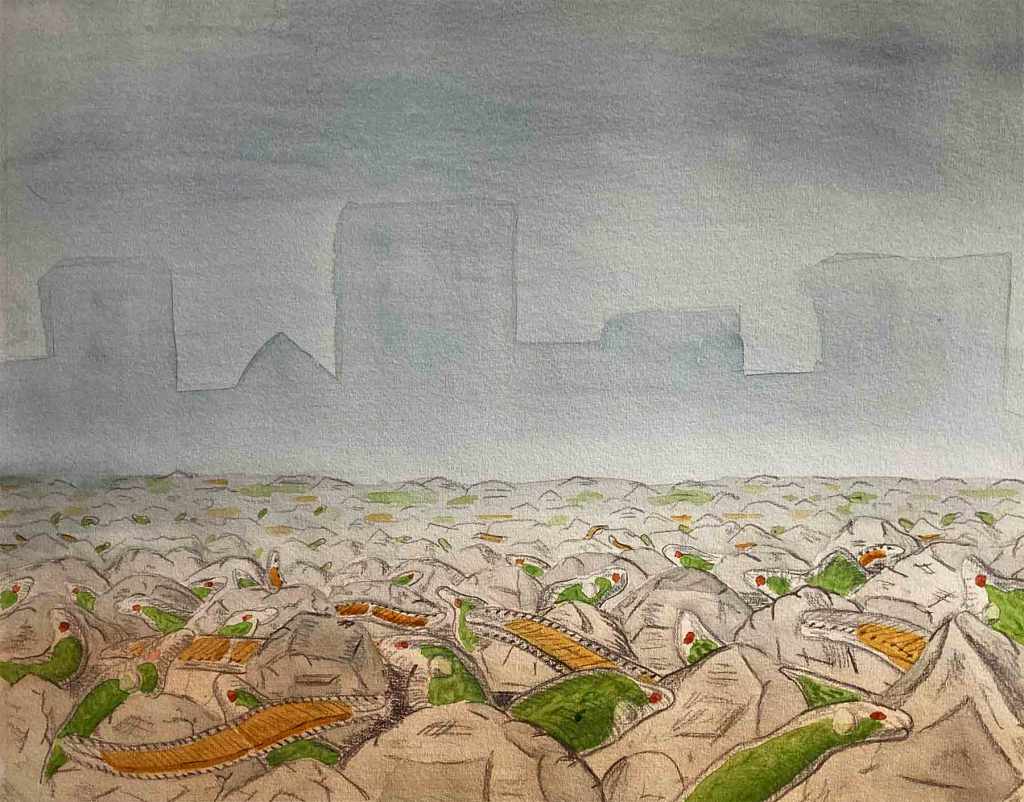I’ve written about the different colours of the mud in Deptford Creek; yellow-brown in areas where the diatoms are thriving and green where Euglena is predominant. In between, there are areas of plain, unprepossessing brown mud. Take a few steps in any direction and the colours of mud will change. Alternatively, imagine standing still for a period of time. You’ll see the colours on a single patch of mud changing. Admittedly, you’ll get rather damp and cold in the process because the tide will come and go, and your legs will be tired, as you really need to stay in one place for an entire tidal cycle (that’s 12 hours). But you’ll learn that these coloured patches are a phenomenon that occurs on exposed mud. As the water level rises, so the colours fade back to a uniform muddy brown.
The scientific literature refers to this as “migration” but “commuting” is probably a better term (and more appropriate, given our proximity to London’s financial centre). A commuter lives in one place and moves daily to and from work. Our algae all “live” in Deptford, and they have a short commute (about a millimetre) to contribute to the “carbon economy”. During the summer, they work long days, sometimes (depending on the tide cycles) taking a prolonged “siesta” in the middle of the day when the tide comes in, and then working long into the evening. On days like the one when I visited, however, their working hours are similar to those of the humans around them, with the start time changing each day to keep pace with the monthly cycle between neap and spring tides.
The picture at the top of the post shows the Euglena and Nitzschia cells as they reach the surface, ready to start their day’s work. As I painted it, I was thinking of Jason’s penultimate challenge before he was given the golden fleece: he had to sow the teeth of a bull into a field, which then sprouted into an army of well-armed soldiers. I’ve captured the moment when the algae start to “sprout” at the surface. The green and golden-brown patches that I described in earlier posts will have been exposed for longer and be composed of many layers of cells, each jostling for position (“survival of the fittest” rules on Deptford’s mudflats, just as in the financial institutions that inhabit Canary Wharf’s skyscrapers).
The lower picture shows how the images relate to the tidal cycle (represented as a sine wave in the upper image). When the tide is high, the algae are below the surface (a.) but when it is low, they are at the surface (b.), so long as it is daylight). Light seems to be the most important factor, but tidal cycles and temperature also play a role. Algal cells start to move away from the surface before the mud is submerged, suggesting that movement is controlled by more than just external cues. Very roughly, diatoms seem to move about a millimetre an hour (i.e. about ten times their own body length). The depth of their daily commute is quite variable – very little light penetrates beyond the first half millimetre of sediment but a deep migration will soon encounter a black layer with no oxygen and potentially toxic sulphides. The depth also depends on the type of sediments, and the local habitat, but think in terms of a couple of millimetres as a rule of thumb. It is a tiny distance by human standards, but enough to take them away from the physical forces that may batter them as the tide comes in, whilst still being one that can be ascended relatively rapidly as the tide goes out.
Diatom movements in relation to tidal cycles in Deptford Creek. The sine wave showing the tidal cycle and the black/grey bars showing nighttime are roughly coincident with conditions on the day of my visit. The lower images show the algae below the sediment surface at high tide (a.) and at the surface at low tide (b.). The Euglena cells are about a 10th of a millimetre long. The image at the top is a representation of the view at the mud surface at low tide.
What’s the point of it all? Remember that photograph of a flounder that I included in my first post from Deptford Creek? That fish eats smaller fish and invertebrates – worms and small crustaceans for example. Most of these are opportunistic scavengers and omnivores, and these algal films will represent one of many possible items in their diet. So a flounder is, at least in part, reformulated algae (in the same way that humans are reformulated wheat, rice and, at this time of year, turkey and chocolate). It has been estimated that up to about a third of all the carbon fixed in estuaries comes from these biofilms, so they are the intertidal equivalent of the Tesco Local that I passed on my way from Cutty Sark station to theDeptford Discovery Centre.
Reference
Consalvey, M., Paterson, D.M. & Underwood, J.R.C. (2004). The ups and downs of life in a benthic biofilm: migration of benthic diatoms. Diatom Research 19: 181-202.
Some other highlights from this week:
Wrote this whilst listening to: The Tide is High by Blondie, obviously, plus Sufjan Steven’s Songs forChristmas and RM Hubbert and Aiden Moffat’s Ghost Stories for Christmas.
Currently reading:Amy-Jane Beer’s The Flow, an exploration of rivers and their place in English culture.
Cultural highlight: Bradley Cooper’s film Maestro, about the life of Leonard Bernstein. Not as good as Tár but asks similar questions (can a monster produce great art?)
Culinary highlight: vegetarian mezé at Bubala in Spitalfields, London, washed down by an Pfälzer orange wine.



Pingback: What lurks beneath The Skating Minister? – microscopesandmonsters